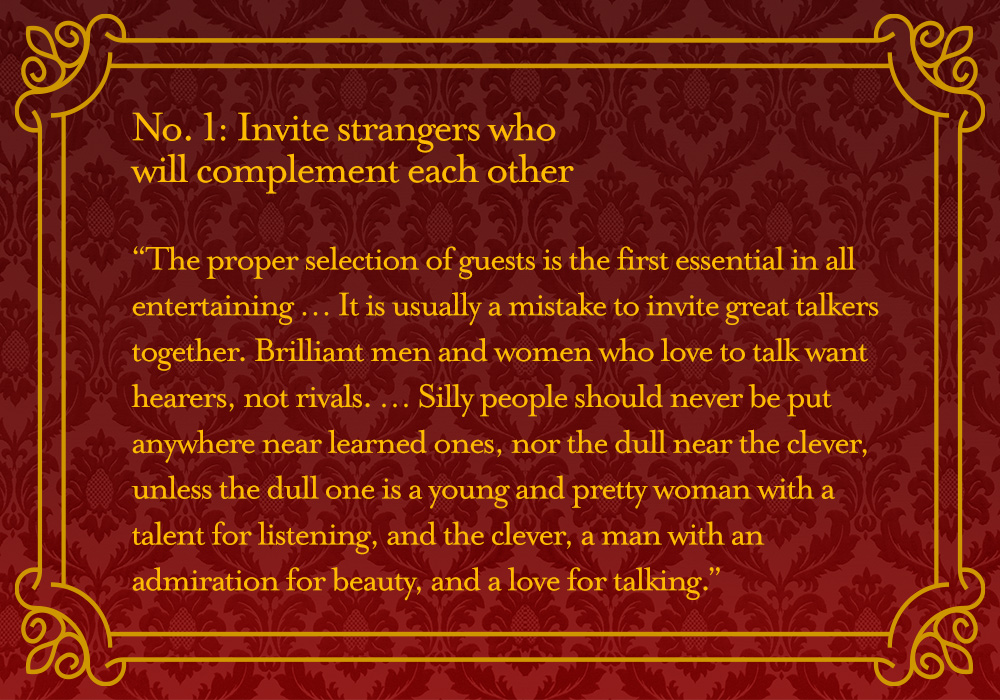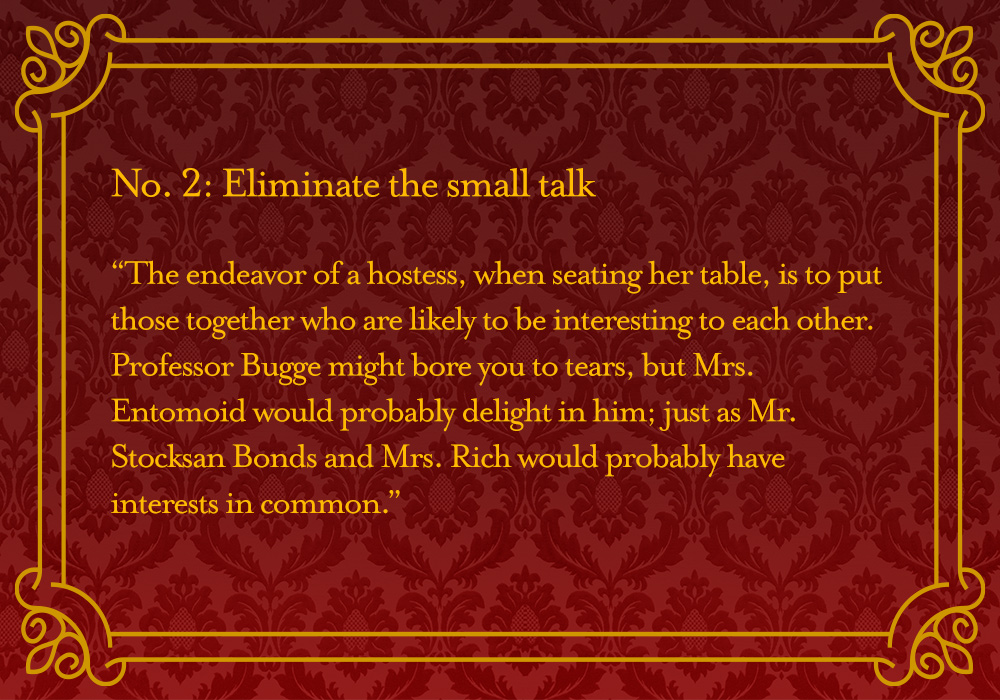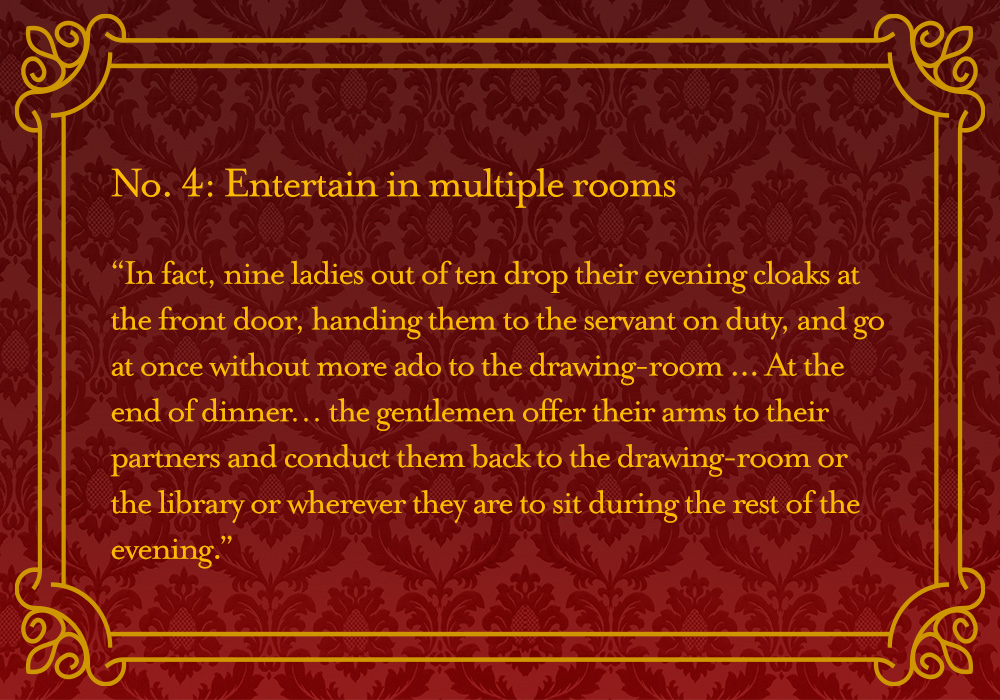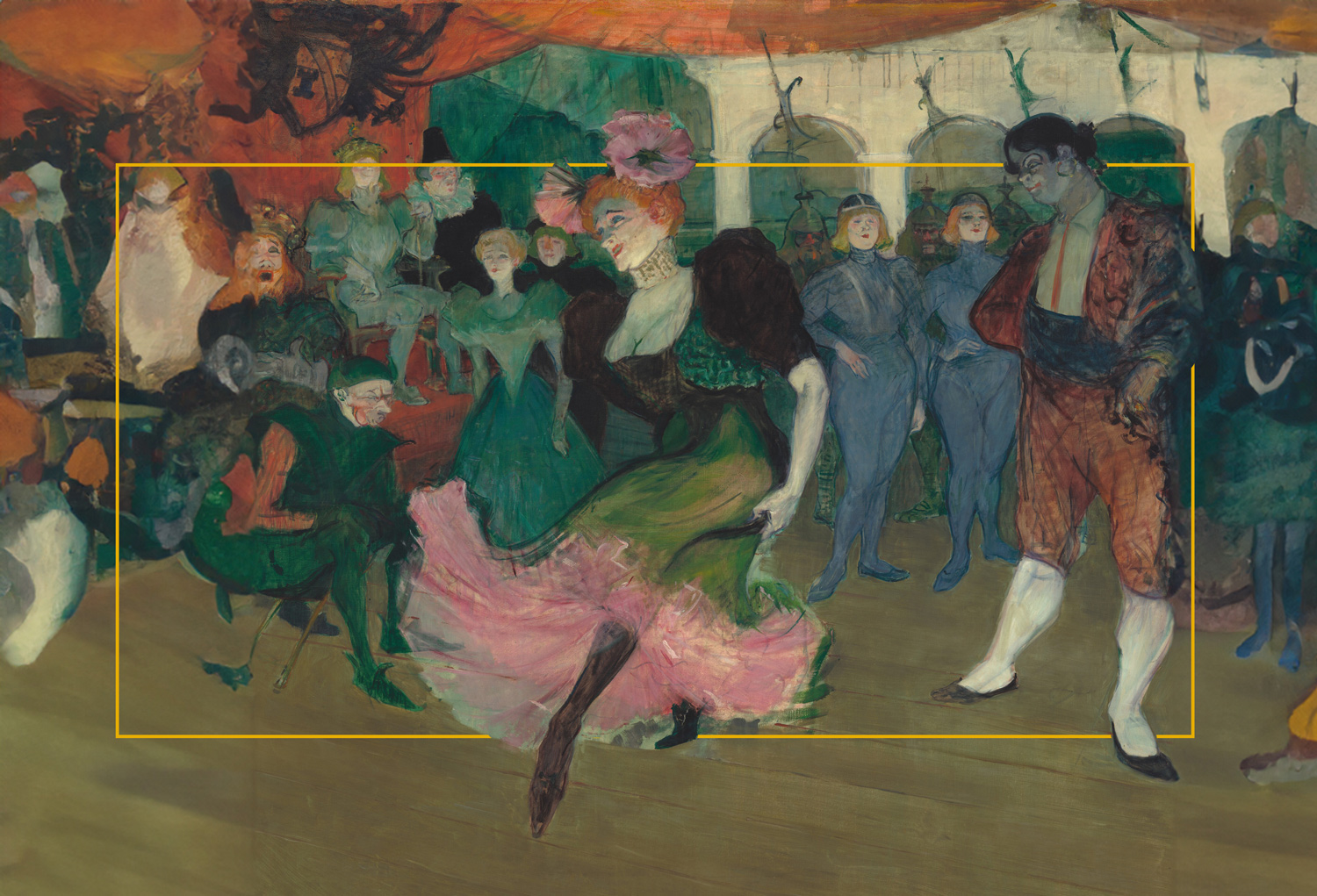By Gia Miller
When it comes to dinner parties, a lot has changed over the years. When Emily Post’s book “ETIQUETTE” was first published in 1922, the wealthy were still literally rolling out the red carpet for their dinner guests. There were so many home entertaining rules that Post dedicated well over 20,000 words to the topic.
Today, though, our casual gatherings are often so informal that they go by in an unremarkable blur. Think about it: What do you recall about the last few dinner parties you hosted or attended? The food? The table setting? The guests? The conversation? Do you have several distinct memories of the occasion, or does everything seem to blend together?
There’s something to be said for having a plan and creating a gathering that you and your guests will remember. And no, we’re not suggesting you need to ensure everything on the table is, per Ms. Post, “geometrically spaced,” that there’s at least “a foot of space between dining chairs” (because, elbow room) or that the silver is perfectly polished (since “anything is better than yellow-faced dirty-finger-nailed silver”). Instead, it’s about the planning and the details—from compiling the ideal guest list to choosing the perfect after-dinner games—as well as being both thoughtful and creative in how you piece it all together.
So, we pulled the gems of wisdom and humor (she was actually quite funny) from Ms. Post’s original tome that are still relevant today. Then we paired them with our own research on episodic memories, along with the knowledge we’ve gained from reading way too much and listening to way too many podcasts. And we came up with our top five ways to make your dinner parties more memorable.

“The proper selection of guests is the first essential in all entertaining … It is usually a mistake to invite great talkers together. Brilliant men and women who love to talk want hearers, not rivals. … Silly people should never be put anywhere near learned ones, nor the dull near the clever, unless the dull one is a young and pretty woman with a talent for listening, and the clever, a man with an admiration for beauty, and a love for talking.”
Before you even begin to plan a menu or create a theme, think carefully about who you will invite. A group of people who all know and like each other will ensure a pleasant enough evening, but you’ll need to work a bit harder to make it a memorable one (see below).
Consider inviting people who don’t know one another but whose personalities align. It instantly allows for fresh conversations and learning throughout the evening. But, as Post advises, be careful about this group: a room full of Type A personalities, jokesters or know-it-alls can make for an intense or competitive night.
In addition, try to include a variety of professions, personal interests and backgrounds that will mesh with each other, so everyone has at least one other person with something in common. For example, a photographer and a hiker can bond over their love of nature, or a gardener and an avid cook can discuss their passion for fresh, local produce.
It’s also a good idea to be mindful of people’s personal passions, including what they loathe or could potentially spark an argument.
“…but ask people out of their own groups and seat them next to their pet aversions, and wild horses could not drag them to your house again!”
Ms. Post really nailed it on this point. Imagine an avid hunter and a devout vegan seated together at your table. While they may engage in a lengthy conversation, there’s a good chance it could become a “throw the dinner plate across the room” scenario. And although it would likely be a meal no one will soon forget, it would also likely be the last time your guests accept a dinner invitation from you, and who could blame them?

“The endeavor of a hostess, when seating her table, is to put those together who are likely to be interesting to each other. Professor Bugge might bore you to tears, but Mrs. Entomoid would probably delight in him; just as Mr. Stocksan Bonds and Mrs. Rich would probably have interests in common.”
If your guests’ names aren’t quite as obvious as Post’s, or even if they are, we’d like to champion the return of name tags. With a little creativity, name tags can help strangers dive right into an interesting conversation.
For example, we held our holiday party at a music venue, so we asked each guest to write their name and answer the following question: “Aliens invade. What musician will save us?” The evening was filled with strangers who began conversations with, “Did you go to their last concert?” or “Do you remember their first album?” and even “Why Prince? How would he save the world?”
This simple (yet thought-provoking) question allowed strangers to easily enter into conversations without the awkwardness of trying to find common ground.
For your dinner party, your question could be related to the evening’s theme (if there is one) or completely random. For example:
- What TV show would you want to live in?
- What was the coolest thing that happened to you this month?
- If you could be a superhero, what superpowers would you have?
- What movie has the best life lessons?
- If you could be a child again, what age would you like to be?

“In giving informal or little dinners, you need never worry because you cannot set the dishes of a ’professional’ dinner-party cook before your friends or even strangers; so long as the food that you are offering is good of its kind. … Typical dinner-party dishes are invariably the temptation, no less than the downfall of, ambitious ignorance.”
We’d like to suggest taking this one step further: don’t cook the meal yourself, and don’t do a potluck. Instead, invite your dinner party guests to prepare the meal together.
Keep the meal simple, with either one main dish and a few sides or several small plates that everyone can share. Purchase all the ingredients ahead of time, and instead of assigning meals or tasks to your guests, let them choose what they would like to make, hopefully with someone they don’t already know.
The idea is for your guests to get to know each other, again skipping the small talk. Plus, odds are, if they’re making the meal, they’re more likely to remember it.

“In fact, nine ladies out of ten drop their evening cloaks at the front door, handing them to the servant on duty, and go at once without more ado to the drawing-room … At the end of dinner… the gentlemen offer their arms to their partners and conduct them back to the drawing-room or the library or wherever they are to sit during the rest of the evening.”
Studies have shown that encoding memories relies on a person paying attention to the event or information. And researchers have found that episodic memories (those of a specific event) are often presented as visual images representing short periods of time.
So create a memorable event by changing the scenery. If everything happens in the kitchen or around the dining table, it often becomes one blended memory. But moving from room to room (cocktails outside, dinner at the table, dessert in the living room), can change that. Your dinner party transforms from one scene to several different “events.”
Plus, moving from one room to another breaks up the evening into shorter periods of time and spurs people to pay attention to their new surroundings, increasing the likelihood of creating several distinct memories of the night.

“In this day when conversation is not so much a ’lost’ as a ’wilfully abandoned’ art, people in numbers can not be left to spend an evening on nothing but conversation. Grouped together by the hundred and with bridge tables absent, the modern fashionables in America, and in England, too, are as helpless as children at a party without something for them to do, listen to, or look at!”
After the meal has ended and you’ve moved away from the table, it’s time for an after-dinner drink and some fun.
Whether it’s a classic like Backgammon, a board game like Settlers of Catan or a team competition like Codenames, adults can (and should) play games, too. It’s a great way to break any still-frozen ice, laugh a little (even at yourself!) and have a genuinely good time.
Because, really, what’s the point of throwing a dinner party if you can’t have a little fun?
This article was published in the March/April 2024 print edition of Connect to Northern Westchester.
Gia Miller is an award-winning journalist and the editor-in-chief/co-publisher of Connect to Northern Westchester. She has a magazine journalism degree (yes, that's a real thing) from the University of Georgia and has written for countless national publications, ranging from SELF to The Washington Post. Gia desperately wishes schools still taught grammar. Also, she wants everyone to know they can delete the word "that" from about 90% of their sentences, and there's no such thing as "first annual." When she's not running her media empire, Gia enjoys spending quality time with friends and family, laughing at her crazy dog and listening to a good podcast. She thanks multiple alarms, fermented grapes and her amazing husband for helping her get through each day. Her love languages are food and humor.











